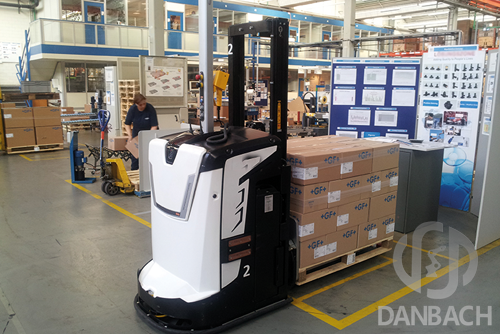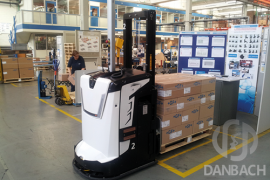The Load Transfer Vehicle AGV, also reffered to as Unit load automated guided vehicles (AGVs), include AGV typically interfaces with stands and conveyors. The Load Transfer Vehicle include AGVs that are designed to move loads at high throughput between workstations in a production environment or between the intelligent warehousing and production. Load Transfer Vehicle AGV are the most traditional type of automated guided vehicle (AGV).

Load Transfer Vehicle AGVs Working Features
Load Transfer Vehicle AGVs are loaded by other manual or automatic equipment (cranes, forklift trucks, other AGVs, etc). These automated guided vehicles carry one, two or four loads at a time and interface with conveyors, stands, end-of-line equipment (palletisers, wrappers, robots) and automatic warehouse equipment (stacker cranes). One of the most common types of transfer devices on unitload AGVs is the roller conveyor. In this case handshake sensors are used both onboard and offboard the AGV to communicate with the offboard conveyor system to ensure a smooth transfer of the load.
Other Unit load automated guided vehicles (AGVs):
roller conveyors (single, dual, four positions)
chain conveyors
lift platforms
belt conveyors
shuttle system
push-pull systems with non driven rolls
These automatic guided carts are configured to carry and transfer pallets (wooden, slave, packed, unpacked), racks, bins, rolls, containers, unitized loads, etc. LTV automated guided vehicles can also be equipped with a top-press to handle unstable loads.
| AGV Type | Load Transfer Vehicle AGV |
| External Dimension | L850*W350*H350(mm) |
| Control Method | PLC/AGV Moving Control Chip (Optional) |
| Guidance Method | Magnetic Tape Guidance/ Light Electrical Guidance/Laser Guidance(Optional) |
| Moving Direction | Forward, Left, Right, Bifurcate |
| Communication Function | Wireless Lane (Optional) |
| Driving Method | Differential Speed Driving |
| Driving Power | DC24V、DC48V |
| Driving Lifting Type | Manual or Electrical Lifting |
| Carrying Capacity | 100KG, 300KG, 500KG, 1000KG(Optional) |
| Moving Speed | 30-45m/min (optional) |
| Turning Radius | the minimum 500mm (line pavement radius) |
| Guidance Precision | ±10mm |
| Working Type | 24 Hours |
| Gradeability | 3-5 degree |
| Stop Precision | ±10mm |
| Charging Type | Manual Charging (optional automatic charging) |
| Battery | Maintenance Free Battery,Continuous discharge number>300 times |
| Safety Induction Range | ≤3m,Adjustable 20mm the distance for emergency brake is less than 20mm |
| Human-machine Interaction | the touch screen human-machine interaction is adopted to easily set the parameter, site or alarm. |
| Working Environment | Indoor Temperature: 0-40 Celsius Degree Relative Humidity: 40%-80% |
| Safety Protection | Front Obstacle Testing Sensor + Mechanical Anti-collision Mechanism |
| Design Life | >10 Years |
The unit load AGV is available for loads of many sizes and shapes and is sometimes used as an assembly AGV where a product is moved from manufacturing cell to manufacturing cell as it is assembled. The types of loads typically moved by unit load AGVs include standard pallets (wrapped and unwrapped), drums, carts, racks, rolls, and custom containers.
Unit load AGVs use more complex drive/steer wheel combinations. Although more expensive, dual and quad steer unit load AGVs are sometimes required where the AGV must maneuver in extremely tight space to pick up or deliver the load.
 中文
中文 English
English

